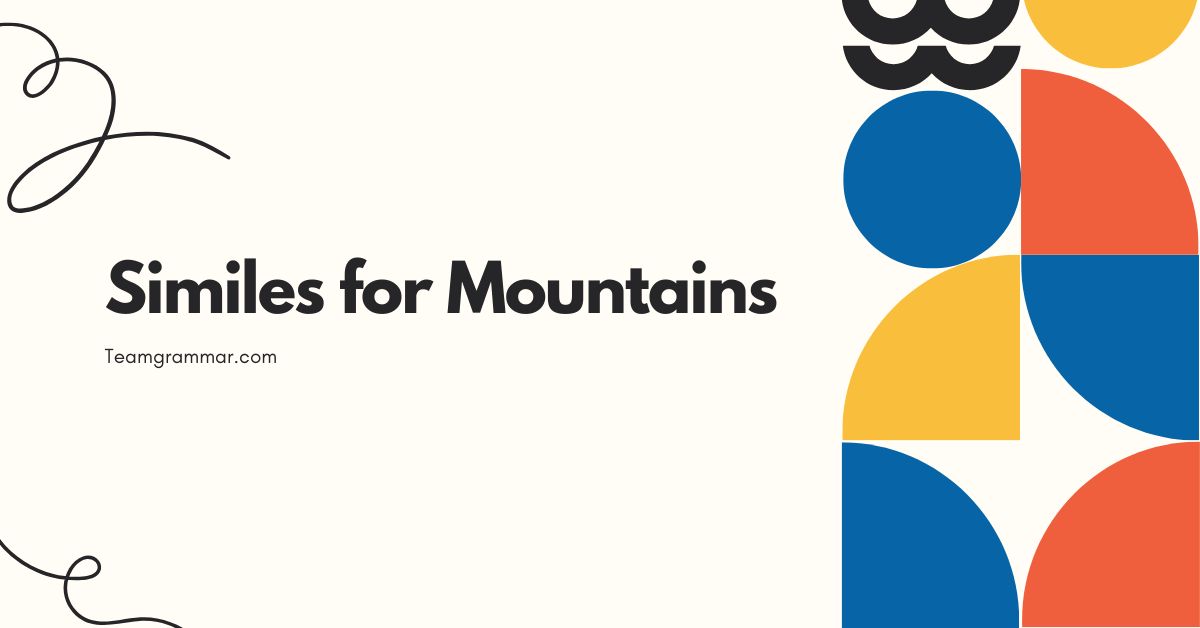39 Similes for Mountains: Mastering Figurative Language
Understanding similes is crucial for enhancing descriptive writing and adding depth to your communication. Similes, by comparing one thing to another using “like” or “as,” allow writers to create vivid imagery and convey complex ideas in an accessible way.
This article focuses specifically on similes used to describe mountains, exploring how these comparisons can evoke a sense of grandeur, permanence, and awe. This guide is beneficial for students, writers, and anyone looking to improve their command of figurative language.
Table of Contents
- Introduction
- Definition of Similes
- Structural Breakdown of Similes
- Types of Mountain Similes
- Examples of Similes for Mountains
- Usage Rules for Similes
- Common Mistakes with Similes
- Practice Exercises
- Advanced Topics in Similes
- Frequently Asked Questions
- Conclusion
Definition of Similes
A simile is a figure of speech that compares two unlike things using the words “like” or “as.” The primary function of a simile is to create a vivid image or enhance understanding by drawing a parallel between something familiar and something less so. Similes are essential tools in descriptive writing, poetry, and even everyday conversation, adding color and depth to language.
In the context of describing mountains, similes can help convey the scale, texture, and emotional impact of these natural formations. By comparing mountains to other objects or concepts, writers can evoke a sense of their immense size, ruggedness, or serene beauty.
The effectiveness of a simile lies in its ability to create a memorable and relatable image in the reader’s mind.
Classification of Similes
Similes can be classified based on the type of comparison they make. Some similes focus on physical attributes, while others emphasize emotional or abstract qualities.
Understanding these classifications can help writers choose the most effective simile for their intended purpose.
- Physical Similes: These compare the physical appearance or characteristics of the mountain to something else (e.g., “as tall as a skyscraper”).
- Emotional Similes: These evoke a feeling or mood associated with the mountain (e.g., “like a sentinel guarding the valley”).
- Abstract Similes: These compare the mountain to an abstract concept or idea (e.g., “as timeless as eternity”).
Function of Similes
The primary function of similes is to enhance description and create a more engaging reading experience. They allow writers to convey information in a more creative and memorable way, making the text more appealing and impactful.
Similes can also be used to clarify complex ideas by relating them to something more familiar.
For example, describing a mountain as “like a sleeping giant” not only conveys its size and shape but also evokes a sense of stillness and potential power. This type of simile adds depth and richness to the description, making it more evocative and memorable.
Contexts for Using Similes
Similes are appropriate in a wide range of contexts, from formal writing to casual conversation. They are particularly effective in creative writing, where vivid imagery and descriptive language are essential.
Similes can also be used in persuasive writing to make an argument more compelling or relatable.
In scientific writing, similes can be used to explain complex concepts in a more accessible way. For example, a geologist might describe the layers of rock in a mountain as “like the pages of a history book,” helping readers understand the geological history of the area.
Structural Breakdown of Similes
A simile typically consists of two main components: the subject being described (in this case, a mountain) and the object or idea to which it is being compared. These two components are linked by the words “like” or “as.” Understanding the structure of a simile is essential for creating effective and grammatically correct comparisons.
The basic structure of a simile is: [Subject] + [linking word (like/as)] + [Object of comparison]. For example, “The mountain is like a fortress.” Here, “mountain” is the subject, “like” is the linking word, and “fortress” is the object of comparison.
Subject of the Simile
The subject of the simile is the entity being described. In the context of this article, the subject will always be a mountain or some aspect of a mountain (e.g., its peak, its slope, its shadow).
The subject should be clearly defined to avoid confusion.
Consider these examples:
- “The mountain’s peak” is the subject in “The mountain’s peak is as sharp as a knife.”
- “The mountain range” is the subject in “The mountain range is like a sleeping dragon.”
- “The shadow of the mountain” is the subject in “The shadow of the mountain is like a dark blanket.”
Linking Word
The linking word is either “like” or “as.” These words establish the comparison between the subject and the object. While both words can be used interchangeably in many cases, there are subtle differences in their usage.
- “Like” is generally used to indicate a similarity or resemblance. For example, “The mountain looks like a giant.”
- “As” is often used to indicate a degree or quality. For example, “The mountain is as tall as a skyscraper.”
Object of Comparison
The object of comparison is the entity to which the subject is being compared. The object should be something that is familiar or easily understood by the reader, allowing them to grasp the intended meaning of the simile.
The object should also share a relevant characteristic with the subject.
Examples of objects of comparison for mountains include:
- Animals (e.g., “like a sleeping bear”)
- Structures (e.g., “like a fortress”)
- Abstract concepts (e.g., “as timeless as eternity”)
- Natural phenomena (e.g., “like a wave frozen in time”)
Types of Mountain Similes
Similes for mountains can be categorized based on the aspect of the mountain they emphasize or the type of comparison they make. Understanding these categories can help writers choose the most effective simile for their specific purpose.
Size and Scale Similes
These similes focus on the immense size and scale of mountains. They often compare mountains to other large objects or structures, emphasizing their imposing presence.
Examples include:
- “As tall as a skyscraper”
- “Like a giant rising from the earth”
- “As vast as an ocean”
Shape and Form Similes
These similes describe the shape and form of mountains, often comparing them to familiar objects or animals. They can emphasize the ruggedness, smoothness, or other distinctive features of the mountain’s appearance.
Examples include:
- “Like a sleeping dragon”
- “As jagged as broken glass”
- “Like a wave frozen in time”
Texture and Surface Similes
These similes focus on the texture and surface of mountains, describing their roughness, smoothness, or other tactile qualities. They can evoke a sense of the mountain’s physical presence and its interaction with the elements.
Examples include:
- “As rough as sandpaper”
- “Like a wrinkled face”
- “As smooth as polished stone”
Emotional and Symbolic Similes
These similes evoke a feeling or mood associated with mountains, often comparing them to abstract concepts or emotional states. They can convey a sense of awe, reverence, or other emotional responses to the mountain’s presence.
Examples include:
- “Like a sentinel guarding the valley”
- “As timeless as eternity”
- “Like a monument to perseverance”
Examples of Similes for Mountains
Here are several examples of similes used to describe mountains, organized by category. These examples illustrate the variety of ways in which similes can be used to enhance descriptive writing and evoke vivid imagery.
Size and Scale Examples
The following table provides examples of similes that emphasize the size and scale of mountains. These comparisons help to convey the immense size and imposing presence of these natural formations.
| Simile | Explanation |
|---|---|
| As tall as a skyscraper | Emphasizes the mountain’s height by comparing it to a very tall building. |
| Like a giant rising from the earth | Conveys the mountain’s immense size and its emergence from the ground. |
| As vast as an ocean | Highlights the mountain’s extensive size and breadth. |
| Like a colossal pyramid | Compares the mountain’s shape and size to a massive, ancient structure. |
| As immense as a sleeping titan | Evokes a sense of the mountain’s great size and potential power. |
| Like a wall between worlds | Suggests the mountain’s imposing presence and its role as a barrier. |
| As towering as a cathedral | Compares the mountain’s height and grandeur to a sacred building. |
| Like a natural fortress | Highlights the mountain’s size and its defensive capabilities. |
| As massive as a continent | Emphasizes the mountain’s enormous size and its resemblance to a large landmass. |
| Like a frozen wave of earth | Conveys the mountain’s size and its dynamic, wave-like shape. |
| As high as the heavens | Emphasizes the mountain’s extreme height, almost reaching the sky. |
| Like a stairway to the clouds | Suggests the mountain’s height and its connection to the sky. |
| As broad as a battlefield | Compares the mountain’s width to a large, open area. |
| Like a sleeping god | Conveys the mountain’s immense size and its sense of ancient power. |
| As substantial as a bedrock of the world | Highlights the mountain’s solid and foundational nature. |
| Like a guardian of the land | Suggests the mountain’s protective role and its imposing presence. |
| As gigantic as a prehistoric beast | Compares the mountain’s size to a large, ancient creature. |
| Like a silent observer of time | Emphasizes the mountain’s enduring presence and its role as a witness to history. |
| As extensive as a country | Highlights the mountain range’s vastness and its resemblance to a large territory. |
| Like a colossal sculpture | Conveys the mountain’s impressive size and its artistic form. |
| As imposing as a king on his throne | Emphasizes the mountain’s dominant presence and its regal appearance. |
| Like a fortress of stone | Highlights the mountain’s strength and its defensive capabilities. |
| As grand as an ancient temple | Compares the mountain’s majesty and its sense of historical significance. |
Shape and Form Examples
The following table provides examples of similes that describe the shape and form of mountains. These comparisons help to convey the visual characteristics and unique features of these natural formations.
| Simile | Explanation |
|---|---|
| Like a sleeping dragon | Suggests the mountain’s long, undulating shape and its potential power. |
| As jagged as broken glass | Highlights the mountain’s sharp, irregular peaks and ridges. |
| Like a wave frozen in time | Conveys the mountain’s dynamic, wave-like shape and its sense of arrested motion. |
| As rounded as a giant’s back | Describes the mountain’s smooth, curved shape and its immense size. |
| Like a pyramid reaching for the sky | Compares the mountain’s shape to a triangular structure ascending upwards. |
| As pointed as a spear | Highlights the mountain’s sharp, conical peak. |
| Like the spine of the earth | Suggests the mountain’s long, ridge-like shape and its foundational role. |
| As craggy as an old man’s face | Compares the mountain’s rough, uneven surface to the wrinkles of an elderly person. |
| Like a fortress of stone | Highlights the mountain’s solid, defensive shape and its imposing presence. |
| As smooth as polished marble | Describes the mountain’s sleek, refined surface and its elegant appearance. |
| Like a clenched fist | Conveys the mountain’s compact, powerful shape and its sense of contained energy. |
| As twisted as a gnarled tree | Highlights the mountain’s irregular, contorted shape and its weathered appearance. |
| Like a crouching beast | Suggests the mountain’s low, hunched shape and its potential for hidden danger. |
| As sharp as a knife’s edge | Compares the mountain’s peak to a thin, cutting blade. |
| Like a sentinel guarding the land | Highlights the mountain’s upright, watchful shape and its protective role. |
| As layered as a cake | Describes the mountain’s distinct strata and its stratified appearance. |
| Like a crown upon the earth | Conveys the mountain’s elevated, regal shape and its symbolic importance. |
| As rugged as a warrior’s shield | Compares the mountain’s tough, uneven surface to a protective barrier. |
| Like a guardian watching over the horizon | Suggests the mountain’s commanding presence and its expansive view. |
| As steep as a cliff face | Highlights the mountain’s sharp, vertical incline. |
| Like a natural staircase to the sky | Conveys the mountain’s ascending shape and its connection to the heavens. |
| As symmetrical as a work of art | Compares the mountain’s balanced, harmonious form to a crafted masterpiece. |
Texture and Surface Examples
The following table provides examples of similes that focus on the texture and surface of mountains. These comparisons help to convey the tactile qualities and physical characteristics of these natural formations.
| Simile | Explanation |
|---|---|
| As rough as sandpaper | Highlights the mountain’s coarse, abrasive surface. |
| Like a wrinkled face | Conveys the mountain’s uneven, aged surface and its history of weathering. |
| As smooth as polished stone | Describes the mountain’s sleek, refined surface and its elegant appearance. |
| Like a canvas of textures | Suggests the mountain’s diverse surface features and its intricate composition. |
| As coarse as gravel | Compares the mountain’s surface to small, loose stones. |
| Like a mosaic of rock and snow | Highlights the mountain’s varied surface materials and its contrasting elements. |
| As uneven as a cobblestone street | Describes the mountain’s irregular, bumpy surface and its rugged terrain. |
| Like a patchwork of earth and vegetation | Conveys the mountain’s mix of bare soil and plant life. |
| As gritty as desert sand | Compares the mountain’s surface to the fine, abrasive particles of a desert. |
| Like a tapestry woven with stone | Highlights the mountain’s intricate surface patterns and its complex geological composition. |
| As slick as ice | Describes the mountain’s smooth, slippery surface and its potential for danger. |
| Like a fortress built of granite | Conveys the mountain’s solid, durable surface and its imposing strength. |
| As weathered as an ancient ruin | Compares the mountain’s aged, eroded surface to a historic structure. |
| Like a sculpture carved by time | Highlights the mountain’s artistic form and its history of natural shaping. |
| As soft as moss | Describes the mountain’s gentle, cushioned surface and its ability to support plant life. |
| Like a guardian wrapped in clouds | Suggests the mountain’s enigmatic presence and its connection to the atmosphere. |
| As sharp as broken shale | Compares the mountain’s surface to thin, brittle layers of rock. |
| Like a mosaic of colors | Highlights the mountain’s diverse range of hues and its vibrant appearance. |
| As rugged as a climber’s hands | Conveys the mountain’s challenging surface and its impact on those who attempt to scale it. |
| Like a monument etched by nature | Suggests the mountain’s enduring presence and its history of natural markings. |
Usage Rules for Similes
Using similes effectively requires an understanding of the rules that govern their construction and application. While similes are a form of creative expression, adhering to certain guidelines can ensure clarity and impact.
Clarity and Relevance
The most important rule for using similes is to ensure that the comparison is clear and relevant. The object of comparison should be something that is familiar to the reader and shares a meaningful characteristic with the subject.
Avoid obscure or far-fetched comparisons that may confuse or distract the reader.
For example, comparing a mountain to “a forgotten dream” might be poetic, but it lacks clarity and relevance. A more effective simile might be “as solid as a rock,” which clearly conveys the mountain’s stability and permanence.
Originality
While it is acceptable to use common similes, strive for originality whenever possible. Overused similes can become clichéd and lose their impact.
By creating fresh and imaginative comparisons, you can make your writing more engaging and memorable.
Instead of saying “as tall as a mountain,” try “like a silent giant watching over the land.” This simile is more evocative and creates a stronger visual image.
Grammatical Correctness
Ensure that your similes are grammatically correct. The subject and object of comparison should be in the same grammatical form.
Pay attention to subject-verb agreement and pronoun usage.
For example, “The mountain is like a fortress” is grammatically correct. However, “The mountain like fortress” is incorrect because it lacks the necessary verb (“is”).
Avoiding Mixed Metaphors
A mixed metaphor occurs when two or more unrelated metaphors are combined, creating a confusing or nonsensical image. Avoid mixing metaphors in your similes.
For example, “The mountain is like a sleeping dragon, but also a raging fire” is a mixed metaphor because it combines two contradictory images. It’s better to stick to one consistent comparison.
Common Mistakes with Similes
Even experienced writers can make mistakes when using similes. Understanding these common errors can help you avoid them and improve the quality of your writing.
| Mistake | Incorrect Example | Correct Example | Explanation |
|---|---|---|---|
| Unclear Comparison | The mountain is like a thought. | The mountain is like a silent observer. | The comparison should be clear and relatable. |
| Overused Simile | The mountain is as tall as a mountain. | The mountain is as tall as a skyscraper. | Avoid using clichéd and unoriginal comparisons. |
| Grammatical Error | Mountain like fortress. | The mountain is like a fortress. | Ensure the simile is grammatically correct. |
| Mixed Metaphor | The mountain is like a sleeping dragon, but also a raging fire. | The mountain is like a sleeping dragon. | Avoid combining unrelated metaphors. |
| Inappropriate Tone | The mountain is like a silly joke. | The mountain is like a majestic king. | Ensure the simile matches the tone of the writing. |
Practice Exercises
Test your understanding of similes with these practice exercises. Each exercise includes a set of questions and their corresponding answers.
Exercise 1: Identifying Similes
Identify the similes in the following sentences.
| Question | Answer |
|---|---|
| 1. The mountain peak was as sharp as a knife. | as sharp as a knife |
| 2. The mountain is a majestic monument. | (No simile) |
| 3. The mountain range looked like a sleeping dragon. | like a sleeping dragon |
| 4. The mountain is tall. | (No simile) |
| 5. The mountain’s shadow was like a dark blanket. | like a dark blanket |
| 6. The mountain stood as a guardian of the valley. | as a guardian of the valley |
| 7. The mountain’s face was as rough as sandpaper. | as rough as sandpaper |
| 8. The mountain is an ancient wonder. | (No simile) |
| 9. The mountain’s height is like a stairway to the clouds. | like a stairway to the clouds |
| 10. The mountain is immense. | (No simile) |
Exercise 2: Completing Similes
Complete the following similes with an appropriate object of comparison.
| Question | Answer |
|---|---|
| 1. The mountain is as tall as _____. | a skyscraper |
| 2. The mountain range looks like _____. | a sleeping giant |
| 3. The mountain’s peak is as sharp as _____. | a knife |
| 4. The mountain’s shadow is like _____. | a dark blanket |
| 5. The mountain is as vast as _____. | an ocean |
| 6. The mountain’s surface is as rough as _____. | sandpaper |
| 7. The mountain stands like _____. | a sentinel |
| 8. The mountain is as timeless as _____. | eternity |
| 9. The mountain range is like _____. | a wall |
| 10. The mountain is as imposing as _____. | a king |
Exercise 3: Writing Similes
Write your own similes to describe the following aspects of a mountain.
| Aspect | Example Answer |
|---|---|
| 1. The mountain’s size | The mountain is as massive as a prehistoric beast. |
| 2. The mountain’s shape | The mountain is like a wave frozen in time. |
| 3. The mountain’s texture | The mountain’s surface is as rough as sandpaper. |
| 4. The mountain’s presence | The mountain stands like a guardian of the valley. |
| 5. The mountain’s age | The mountain is as timeless as eternity. |
| 6. The mountain’s peak | The mountain’s peak is as sharp as a knife. |
| 7. The mountain’s shadow | The mountain’s shadow is like a dark blanket. |
| 8. The mountain’s color | The mountain is as colorful as a mosaic. |
| 9. The mountain’s strength | The mountain is as strong as a fortress. |
| 10. The mountain’s beauty | The mountain is as beautiful as a dream. |
Advanced Topics in Similes
For advanced learners, exploring more complex aspects of similes can further enhance their writing skills. These topics include the use of extended similes, metaphorical similes, and the integration of similes with other figures of speech.
Extended Similes
An extended simile is a simile that is developed over several sentences or paragraphs. Instead of a brief comparison, an extended simile explores the similarities between the subject and object in greater detail, creating a more vivid and nuanced image.
For example, instead of simply saying “The mountain is like a sleeping giant,” an extended simile might elaborate on the giant’s posture, the stillness of its breath, and the sense of potential energy it holds.
Metaphorical Similes
A metaphorical simile is a simile that uses a metaphor as the object of comparison. This creates a double layer of figurative language, adding depth and complexity to the comparison.
For example, “The mountain is like a fortress of solitude” combines the simile structure with the metaphor of the mountain as a place of isolation and reflection.
Integration with Other Figures of Speech
Similes can be effectively combined with other figures of speech, such as metaphors, personification, and hyperbole, to create richer and more impactful descriptions. By layering these techniques, writers can create a more immersive and engaging reading experience.
For example, “The mountain, like a sentinel guarding the valley, stood tall and proud, its rocky face a testament to the ages” combines a simile with personification and a metaphor to create a powerful image of the mountain’s presence and enduring strength.
Frequently Asked Questions
Here are some frequently asked questions about similes, along with detailed answers to help you master this figure of speech.
- What is the difference between a simile and a metaphor?
A simile explicitly compares two things using “like” or “as,” while a metaphor directly equates them without using these words. For example, “The mountain is like a fortress” (simile) versus “The mountain is a fortress” (metaphor).
- Can I use similes in formal writing?
Yes, similes can be used in formal writing, but they should be used sparingly and with careful consideration for the tone and audience. They are more common in creative writing and less so in technical or academic writing.
- How can I make my similes more original?
To make your similes more original, avoid using clichéd comparisons and try to find unexpected or imaginative connections between the subject and object. Consider using abstract concepts or unusual objects of comparison.
- What is an extended simile?
An extended simile is a simile that is developed over several sentences or paragraphs, exploring the similarities between the subject and object in greater detail.
- How do I avoid mixed metaphors in my similes?
To avoid mixed metaphors, ensure that the objects of comparison are consistent and related. Avoid combining unrelated images or concepts.
- Is it okay to use the same simile multiple times?
While it is acceptable to use a simile more than once, it is generally best to vary your language and avoid repetition. Overusing a simile can make your writing seem stale or uninspired.
- Can I use similes in everyday conversation?
Yes, similes are commonly used in everyday conversation to add color and emphasis to your speech. They can help you express your ideas more vividly and engagingly.
- How do I choose the right object of comparison for my simile?
Choose an object of comparison that is familiar to your audience and shares a meaningful characteristic with the subject. The object should also be appropriate for the tone and context of your writing.
- What are some common mistakes to avoid when using similes?
Some common mistakes include using unclear comparisons, overusing clichéd similes, making grammatical errors, and creating mixed metaphors.
- How can similes improve my writing?
Similes can improve your writing by adding vivid imagery, enhancing description, clarifying complex ideas, and making your text more engaging and memorable.
Conclusion
Mastering the use of similes is a valuable skill for any writer or communicator. By understanding the structure, types, and usage rules of similes, you can enhance your descriptive writing and create more engaging and impactful messages.
Remember to focus on clarity, originality, and grammatical correctness, and avoid common mistakes such as mixed metaphors and overused comparisons.
As you continue to practice using similes, experiment with different types of comparisons and explore the integration of similes with other figures of speech. With dedication and attention to detail, you can become proficient in using similes to add depth, color, and creativity to your writing.







